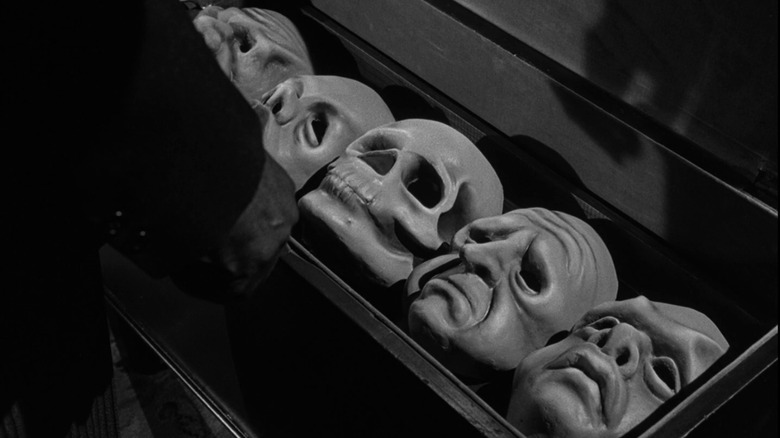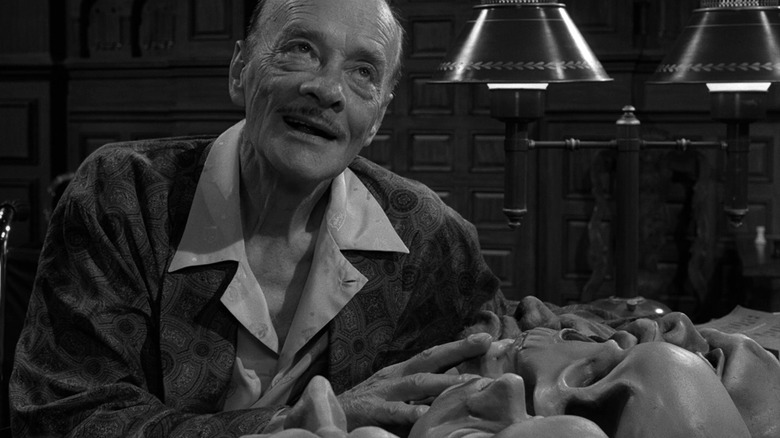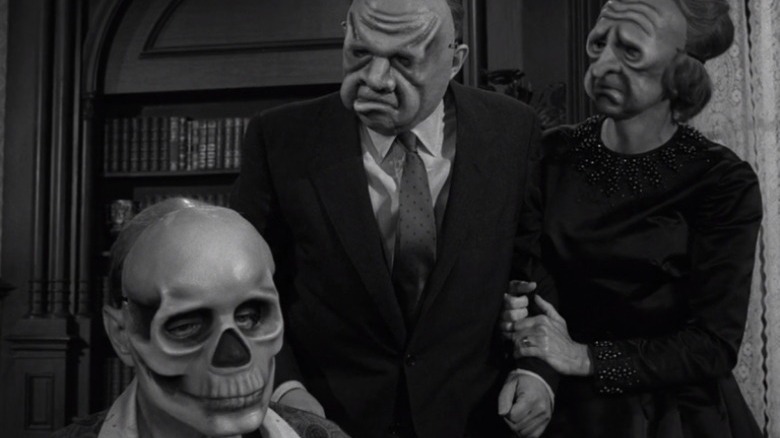The Masks' Director Made Twilight Zone History In More Ways Than One
In the fifth season episode of "The Twilight Zone," called "The Masks" (March 20, 1964), an elderly millionaire named Jason Foster (Robert Keith) has gathered his daughter, her husband, and their two adult children for a Mardi Gras gathering. Jason, attended by his doctor (Willis Bouchey), is dying. He expects he'll be dead by morning. Jason also hates his daughter and her family. He sees Emily (Virginia Gregg) as spineless, her husband Wilfred (Milton Seltzer) as greedy, her son Wilfred, Jr. (Alan Sues) as dumb and oafish, and her daughter Paula (Brooke Hayward) as vain and shallow.
At dinner, the family members all feign politeness, but the audience trusts Jason when he says they are all terrible people who are only interested in inheriting his fortune. After dinner, Jason calls the quartet into the drawing room for a Mardi Gras game. The patriarch has commissioned five expressive, full-face masks that he and his family are to wear. He jokes that the expressions on the masks represent the opposite of their intended wearers' personalities, but are in fact perfectly in keeping with his opinions of them: Emily wears the Coward, Wildred the Miser, Wilfred Jr. the Brute, and Paula the Narcissist. Jason wears a skull face. He declares that if they don't leave their masks on until midnight, they won't inherit a penny.
What follows is a parlor drama where pieces of the characters' dark personalities are revealed. No one is as decent as they purport to be.
They leave the masks on until midnight. When they remove the masks ... well, you'll have to watch the episode to see Rod Serling's twist ending.
"The Masks" was directed by celebrated actress Ida Lupino. A revolutionary piece of trivia: Lupino was the only woman to direct an episode of "The Twilight Zone."
Ida Lupino
It shouldn't need repeating that "The Twilight Zone" was one of the best TV shows of all time. Serling wrote the bulk of the show's episodes (including "The Masks"), but even the episodes written by others were striking and ironic explorations of the human condition. Serling wasn't always cynical about humanity, but he did see a lot of vice, hubris, weakness, and sin in our hearts. He wrote morality fables, often with a supernatural or sci-fi twist.
He also had an eye for talent, and many notable actors appeared in the anthology series, typically for one-off parts. There are too many stars to list here, needless to say, most working actors in the late '50s and early '60s would inevitably show up. "The Twilight Zone" also provided a wonderful venue for up-and-coming directors to ply their craft. Don Siegel, Ted Post, Richard Donner, Christian Nyby and several other notable filmmakers started on the series. Jacques Tourneur also directed an episode.
Lupino was a talented and constantly-working actress who was already helming feature films by the time 1964 rolled around. On her directorial résumé were "Not Wanted," "Hard, Fast and Beautiful," "The Hitch-Hiker," and "The Bigamist." She also directed episodes of "The Rifleman" and "Thriller." She would go on to direct a few episodes of "Gilligan's Island" and "Bewitched." It seems that she was amply prepared to take on a dark fantasy series like "The Twilight Zone." She certainly proved she has a flair for the macabre.
Another fun piece of trivia: Ida Lupino was also the only director of a "Twilight Zone" episode that also appeared as an actress; she also starred in "The Sixteen-Millimeter Shrine" (October 23, 1959) opposite Martin Balsam.
Creating false characters
In "The Sixteen-Millimeter Shrine," Lupino plays Barbara Trenton, a Norma Desmond-type actress whose glory days are long behind her. She has taken to spending her days watching old films of hers from decades before, worshiping at the 16mm shrine. She resents that she is now only offered "mom" roles, preferring to remain an ingenue. It should be noted that Lupino was only 41 at the time, but by showbiz standards — and by the rules of sexism — that was already considered "too old" for Hollywood. Barbara Trenton hates that her old co-stars have returned from acting and turned into middle-aged lumps. She tries to throw a party, but all her intended guests are dead. Barbara finally holes up in her screening room, wishing to be inside the movies again.
Quite literally, she gets her wish.
It should be noted that both "The Masks" and "The Sixteen-Millimeter Shrine" are stories about one's perceived persona vs. their actual persona. One is about how ordinary-looking people cannot mask their inner ugliness. The other is about wielding the artificiality of film as a reasonable substitute for a genuine personality. These are the perfect types of stories for a hardworking actress tp tell. Lupino was, after all, a director-for-hire who was facing the very issues of Hollywood artificiality experienced by her "Shrine" character.
"The Masks," to this day, often tops lists of the best "Twilight Zone" episodes of all time. Lupino did an exemplary job.


